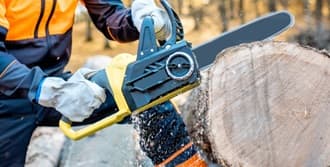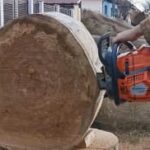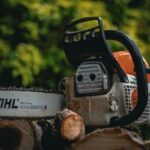As an Amazon Associate, this site earns commissions from qualifying purchases. For more information click here.
Electric chainsaws have become a popular choice for both professional lumberjacks and homeowners due to their efficiency, ease of use, and environmental friendliness. To ensure the longevity and optimal performance of your electric chainsaw, regular maintenance is crucial. In this guide, we will walk you through the essential steps to keep your electric chainsaw in top-notch condition.
Key Takeaways:
- Regularly inspect the chain, chain tension, lubrication, and air filter
- Clean the chain brake regularly to prevent kickbacks
- Store your electric chainsaw in a dry and cool place, away from direct sunlight
Safety First
Before starting the inspection, ensure the chainsaw is powered off and disconnected from any power source. Wear appropriate safety gear, including gloves and safety glasses, to protect yourself from any sharp edges or debris that may be present on the chain.
Secure the Chainsaw
For a more convenient and safer inspection, secure the chainsaw on a stable surface or use a vice to hold it in place. This will prevent any accidental movements and ensure a thorough examination.
Examine the Chain for Wear
Carefully inspect the cutting teeth on the chain. Look for signs of wear, such as rounded edges or uneven lengths. A worn-out chain not only reduces cutting efficiency but can also strain the chainsaw motor. If you notice significant wear, it’s advisable to sharpen or replace the chain.
Scan the entire length of the chain for any visible damage, such as bent or broken teeth. Damaged chains compromise both efficiency and safety during operation. If you identify any issues, it’s crucial to replace the chain promptly to maintain optimal performance.

Measure Chain Tension
Proper chain tension is paramount for safe and efficient cutting. Check the tension by pulling the chain away from the guide bar. There should be minimal slack, and the chain should move freely. Refer to the manufacturer’s guidelines for the specific tension requirements for your electric chainsaw model.
Inspect Drive Links. Examine the drive links on the bottom of the chain that sit in the guide bar groove. Ensure all drive links are intact and in good condition. Damaged or missing drive links can affect the chain’s engagement with the guide bar, leading to operational issues.
Related. Chainsaws for Rent Guide
Check for Lubrication
Adequate lubrication is crucial for smooth chain operation. Verify that the automatic oiling system is functioning correctly and that there is sufficient oil in the reservoir. Proper lubrication prevents overheating and reduces friction during cutting tasks.
Inspect Chain Alignment
Ensure the chain is correctly aligned on the guide bar. Misalignment can result in uneven wear and reduced cutting efficiency. Adjust the chain alignment as needed, following the manufacturer’s instructions provided in the user manual.
Clean the Chain
Use a wire brush or an old toothbrush to remove any debris, sawdust, or resin from the chain. A clean chain operates more efficiently and reduces the risk of overheating. Pay special attention to the spaces between the cutting teeth and the drive links.
Rotate the Chain
Manually rotate the chain around the guide bar to check for smooth movement. Any resistance or unusual sounds may indicate a problem with the chain or guide bar that requires further investigation. Address any issues promptly to prevent further damage.
Electric Chainsaw Maintenance Frequency
The frequency of electric chainsaw maintenance depends on how often you use the tool and the intensity of the cutting tasks. However, a general guideline for routine maintenance is to perform checks and maintenance tasks before and after each use, with more comprehensive maintenance scheduled periodically. Here’s a breakdown:
Before Each Use:
Chain Inspection: Check the chain for any signs of wear, damage, or dullness. Ensure it is properly tensioned.
Chain Lubrication: Confirm that the chain lubrication system is functioning, and there is sufficient bar and chain oil in the reservoir.
Fasteners: Inspect and tighten all fasteners, including those on the chain, guide bar, and handle.
Power Cord (for corded models): Examine the power cord for any damage or fraying. Ensure a secure connection to the power source.
After Each Use:
Clean the Chainsaw: Remove any sawdust, debris, or resin from the chain, guide bar, and other components. Use a wire brush or an old toothbrush for thorough cleaning.
Inspect Chain Brake: Check the chain brake mechanism for proper functioning. Remove any debris that may have accumulated around the brake.
Storage: Store the electric chainsaw in a cool, dry place away from direct sunlight. Consider using a protective case or cover to prevent damage during storage.
Periodic Maintenance (Every 5-10 Hours of Use or Monthly):
Chain Sharpening: Sharpen the chain as needed, depending on usage. A sharp chain ensures efficient cutting and reduces strain on the motor.
Air Filter: Check and clean or replace the air filter as recommended by the manufacturer. A clogged air filter can affect performance.
Guide Bar Maintenance: Inspect the guide bar for wear and rotate it periodically. Replace the guide bar if it shows signs of excessive wear.
Inspect Power Cord (for corded models): Check the power cord for any signs of wear or damage. Replace the cord if necessary.
Battery Maintenance (for cordless models): If your electric chainsaw is cordless, follow the manufacturer’s guidelines for battery maintenance, including charging and storage recommendations.
Annual Maintenance:
Professional Inspection: Consider taking your electric chainsaw to a professional for a more thorough inspection and tune-up, especially if you use it frequently or for heavy-duty tasks.
Motor Inspection: Check the motor housing for any signs of wear or damage. Ensure that vents are clear for proper cooling.
Always refer to your electric chainsaw’s user manual for specific maintenance guidelines provided by the manufacturer. Tailor your maintenance schedule based on your usage patterns and the recommendations outlined in the manual. Regular maintenance not only ensures the longevity of your electric chainsaw but also contributes to safer and more efficient operation.
Signs of Electric Chainsaw Wear and Tear
Identifying signs of wear and tear in electric chainsaws is crucial for ensuring their continued performance, efficiency, and safety. Here are common indicators that your electric chainsaw may be experiencing wear and tear:
Dull Cutting Performance
If your chainsaw struggles to cut through wood efficiently or requires more effort than usual, it may be a sign that the chain is dull. Dull cutting teeth reduce the chainsaw’s effectiveness and can put unnecessary strain on the motor.
Uneven Cutting or Crooked Cuts
An electric chainsaw in good condition should produce clean and straight cuts. If you notice the saw drifting to one side or creating uneven cuts, it could be indicative of a worn or improperly tensioned chain.
Excessive Vibration
Increased vibration during operation is often a sign of wear and tear. Loose or damaged components, such as fasteners, guide bars, or chains, can contribute to excessive vibration. Regularly check and tighten all fasteners to maintain stability.
Unusual Noises
Unusual sounds, such as grinding or rattling, can signal internal issues within the chainsaw. Inspect the chain, guide bar, and other components for damage or wear that may be causing these noises.
Reduced Chain Tension
Over time, the chain may lose tension, leading to a sagging appearance. If you notice excessive slack in the chain, it’s crucial to adjust the tension following the manufacturer’s guidelines. Loose chains not only reduce cutting efficiency but also pose a safety risk.
Chainsaw Kickback
Kickback occurs when the chainsaw’s nose suddenly kicks upward, and it can be a result of a worn or improperly tensioned chain. This dangerous phenomenon is often a sign that the chain is not engaging with the wood properly.
Overheating
If your electric chainsaw tends to overheat more frequently than usual, it may indicate a problem with the chain, guide bar, or motor. Overheating can lead to premature wear and may result in more severe damage if not addressed promptly.
Visible Wear on the Chain
Inspect the cutting teeth and drive links on the chain. Signs of wear include rounded or chipped teeth, and any visible damage to these components may affect cutting performance and safety.
Guide Bar Wear
Examine the guide bar for wear, especially on the bar’s nose. Worn guide bars can result in poor cutting precision and may compromise safety. Rotate or replace the guide bar as needed.
Difficulty in Starting
If your electric chainsaw is experiencing difficulty starting or requires multiple attempts, it may indicate wear or issues with the motor, ignition system, or other internal components.
Loose or Damaged Fasteners
Vibrations during operation can cause nuts and bolts to loosen over time. Regularly check and tighten all fasteners, including those on the chain, guide bar, and handle. Damaged or missing fasteners can compromise the chainsaw’s integrity
Conclusion
Regular maintenance is the key to extending the lifespan and ensuring the safety and efficiency of your electric chainsaw. By following these guidelines, you can keep your chainsaw in optimal condition, allowing you to tackle your cutting tasks with confidence and ease. Always refer to the manufacturer’s manual for specific maintenance instructions tailored to your electric chainsaw model.

I love the outdoors and all the tools for maintaining gardens, yards and lawns. The only thing I am more passionate about is sharing what I know about garden and outdoor equipment.


